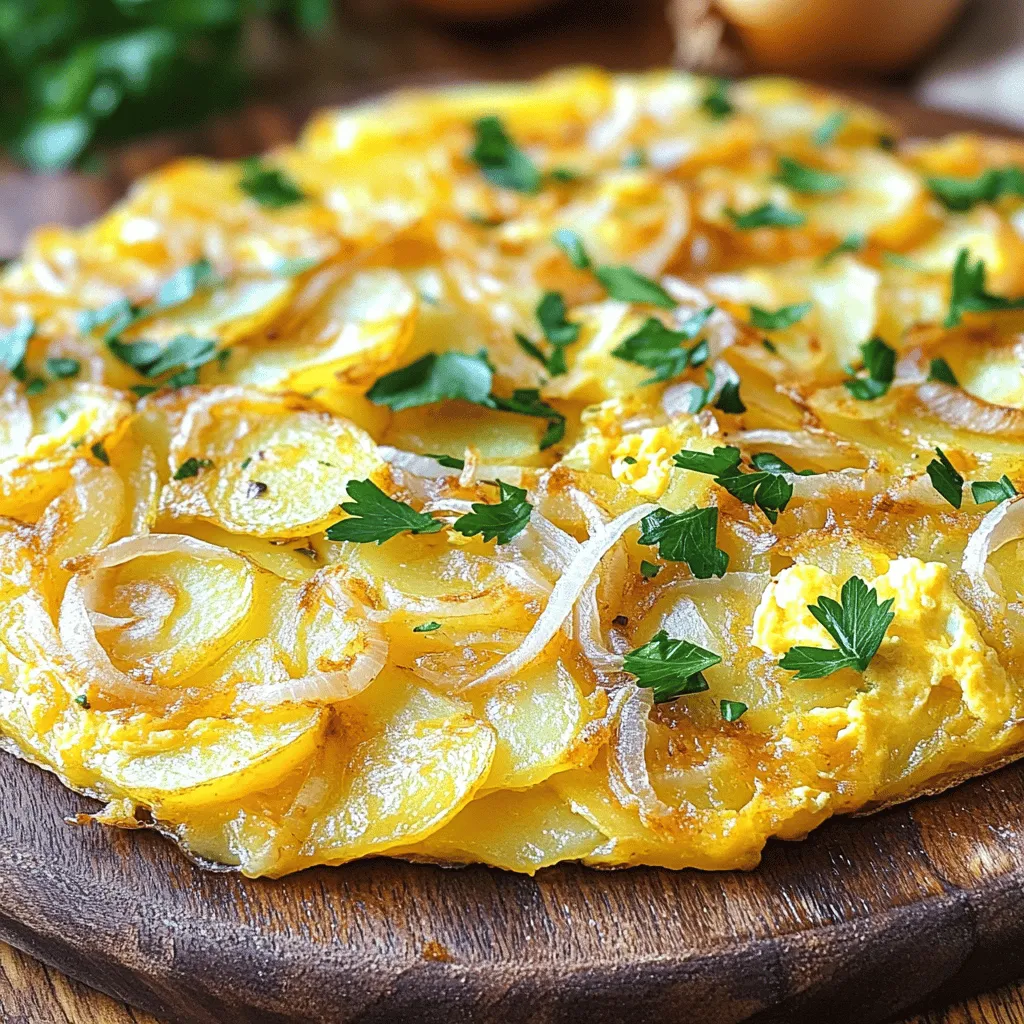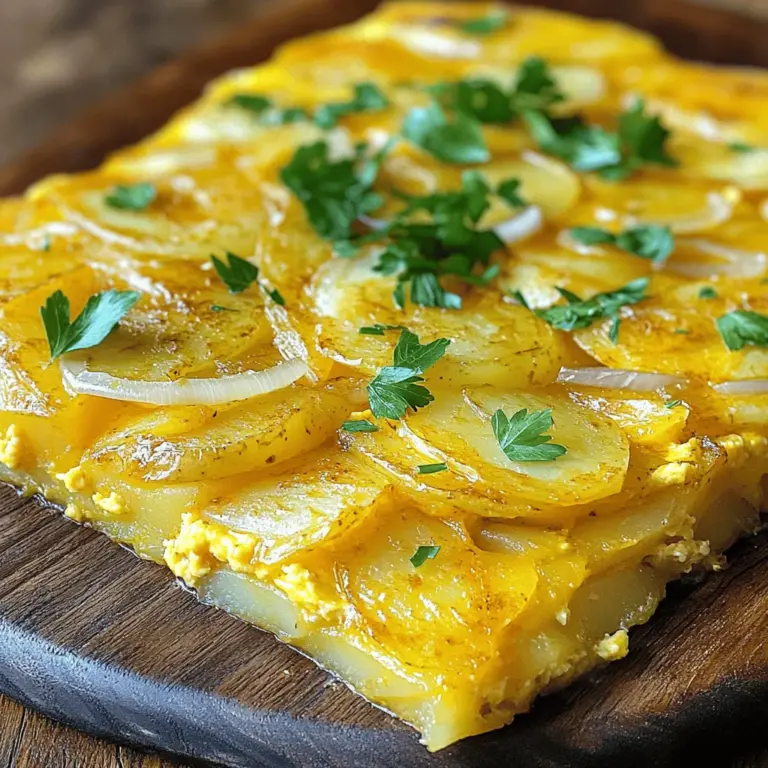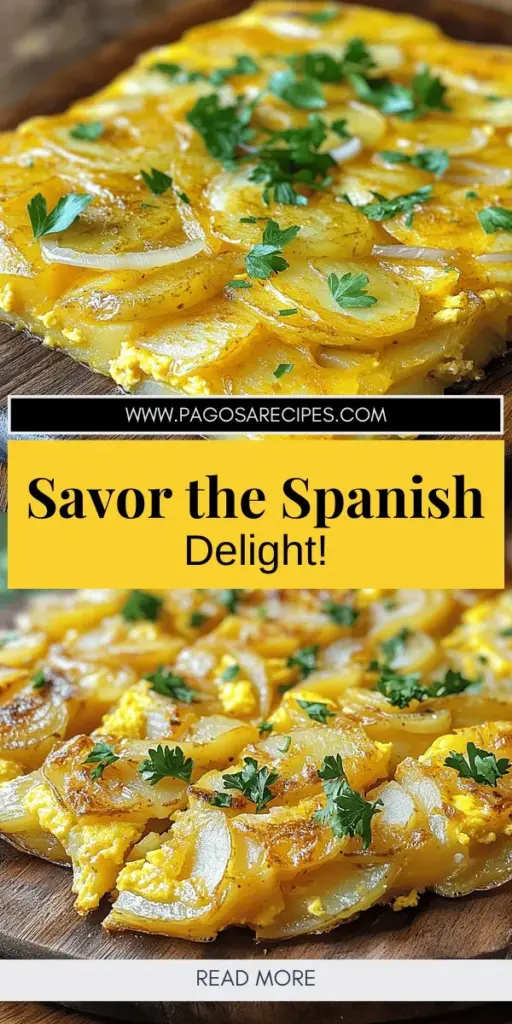If you’ve ever dreamed of experiencing Spain through your taste buds, Tortilla Espanola is your ticket. This classic Spanish egg and potato omelette is far more than just a dish; it’s a beloved tradition. In this article, I’ll guide you through the essential ingredients, share easy cooking techniques, and highlight delicious variations. Ready to impress your friends and family with a homemade Tortilla Espanola? Let’s dive into this simple yet satisfying recipe together!
What are the main ingredients for a traditional Tortilla Espanola?
The classic Tortilla Espanola, or Spanish omelette, needs just a few key ingredients. You start with potatoes, eggs, and often onions. Each ingredient brings its own charm to this dish.
Potatoes are the star. They provide a soft, creamy texture. When you cook them slowly, they soak in the rich olive oil. Their flavor shines through in every bite. Use medium potatoes for the best results. I like to slice them thinly for even cooking.
The eggs play a crucial role. They bind the potatoes together. They also add a lovely, rich taste. Fresh, large eggs work best. Be sure to beat them lightly before mixing. This ensures a fluffy texture in the final dish.
Onions can elevate the flavor. They add a sweet and savory note. When you cook them with potatoes, the flavors blend beautifully. However, if you prefer a simpler version, you can skip the onions.
For this recipe, you also need good olive oil. It adds depth and richness. Use extra virgin olive oil for the best taste. Don’t forget to season with salt and pepper to enhance all the flavors.
How can you effectively make Tortilla Espanola step-by-step?
To make Tortilla Espanola, you need to follow a few key steps.
What are the key techniques for cooking the potatoes and onions?
Start by peeling and thinly slicing the potatoes. Use a sharp knife for even slices. The potatoes need to cook slowly. Heat olive oil in a large skillet over medium heat. Add the sliced potatoes and chopped onion. Season with salt and pepper. Cook gently for about 15-20 minutes. Stir occasionally to prevent sticking. You want the potatoes tender but not mushy. The onions should turn soft and slightly sweet. This combination adds great flavor.
How can you achieve the perfect egg mixture?
While the potatoes are cooking, crack the eggs into a bowl. Use a whisk or fork to beat the eggs lightly. Add a pinch of salt for flavor. The eggs should be well mixed but not frothy. This helps create a smooth texture. Once the potatoes and onions are done, drain them from the oil. You can save some oil for later. Add them to the bowl with the beaten eggs. Gently mix to combine. Make sure the potatoes are coated but intact.
What flipping techniques ensure a perfectly cooked omelette?
To flip the tortilla, use a large plate. Place it over the skillet. Carefully invert the skillet to transfer the omelette onto the plate. This step can be tricky, so take it slow. Add a little more oil to the skillet to prevent sticking. Slide the tortilla back into the skillet to cook the other side. Cook for another 5-7 minutes. You want it golden brown and cooked through. Once done, slide it onto a platter and let it cool slightly.

What are some variations of Tortilla Espanola worth trying?
Tortilla Espanola offers many tasty twists. You can make a vegetarian version by adding spinach or bell peppers. These vegetables add color and flavor. They also bring in extra nutrients that enhance your meal. Try using zucchini or mushrooms as well. They cook well and blend nicely with eggs.
Adding chorizo is another popular variation. This spicy sausage gives the tortilla a smoky kick. The chorizo adds protein, making your meal heartier. It also contrasts beautifully with the softness of the potatoes. If you want extra flavor, cook the chorizo first. This allows its oils to infuse the dish.
Regional variations also exist. In some areas of Spain, people add other ingredients like cheese or herbs. These changes reflect local tastes and traditions. For example, in the Basque Country, you might find tortillas with peppers. Each region puts its spin on the classic recipe.
Experimenting with these variations can make your Tortilla Espanola special.Enjoy creating a dish that reflects your taste!
What tips can help create the perfect Tortilla Espanola?
For a perfect tortilla espanola, start with the right potatoes. I recommend using waxy potatoes, like Yukon Gold or Red Bliss. These potatoes hold their shape well and give a creamy texture. They absorb flavors and cook evenly, making them perfect for this dish.
Next, let’s talk about cooking techniques. To achieve a fluffy tortilla, cook the potatoes slowly. Use medium heat and avoid rushing. This step allows the potatoes to soften without browning too much. Once they are tender, mix them gently with the beaten eggs. Don’t overmix; you want to keep some potato chunks for texture.
Seasoning is key to bringing out the flavors. I use salt and pepper, but you can add a pinch of smoked paprika for a smoky touch. This small addition can elevate the taste of your omelette. Fresh herbs, like parsley, also add brightness when you serve.

What is the history and cultural significance of Tortilla Espanola?
Tortilla Espanola, or Spanish omelet, has deep roots in Spain. It began as a humble dish. Farmers and laborers needed quick meals. They used simple ingredients like potatoes, onions, and eggs. This dish became a staple across Spain for its ease and flavor.
Over time, Tortilla Espanola evolved. It found its way into homes and restaurants. Each region added its twist. Some used different vegetables or spices. These changes reflect local tastes and traditions. Today, it stands as a symbol of Spanish cuisine.
Tortilla Espanola plays a big role in meals. It appears at breakfast, lunch, and dinner. Families share it during gatherings. In Spain, you can find it in tapas bars. People enjoy slices with drinks. This makes it a favorite for social events.
Spanish traditions celebrate this dish too. It often appears during festivals. Families make it for special occasions and holidays. Its presence brings people together. You can feel the love and warmth in every bite.
The history of Tortilla Espanola is rich. It tells a story of culture and community. This simple dish has united people for generations. As you prepare it, you join this tradition.
What are some serving suggestions for enjoying Tortilla Espanola?
Tortilla Espanola is a versatile dish. You can enjoy it any time of day. For breakfast, serve it warm with fresh fruit. This adds a nice touch to your morning. You can also pair it with crusty bread. A simple side salad can add crunch and freshness.
For brunch, slice it into wedges. Arrange these on a platter with olives and cheese. This makes for a colorful and inviting spread. You can even serve it with a garlic aioli for extra flavor. This adds a creamy contrast to the egg and potato.
If you want to make it part of a tapas spread, cut it into small pieces. Serve it alongside other Spanish delights like patatas bravas or jamón ibérico. This way, you create a feast of flavors. Guests can sample different tastes. It’s a fun way to enjoy food together.
When it comes to drinks, consider serving it with a glass of Spanish wine. A chilled white wine pairs wonderfully. You can also try a refreshing sangria. These drinks complement the rich flavors of the tortilla. Sparkling water with lemon is also a great choice.Enjoy your Tortilla Espanola in these delicious ways!
Tortilla Espanola combines simple ingredients to create a delightful Spanish dish. Potatoes give it texture, while eggs provide richness. Onions can add a layer of flavor. Making it is easy once you master cooking techniques and flipping. You can try various vegetables or add proteins like chorizo for a twist. Remember to choose the right potatoes and season well for the best results. This dish is not only a staple in Spanish meals but also holds cultural significance. Enjoying it with the right sides and drinks can elevate your experience.



